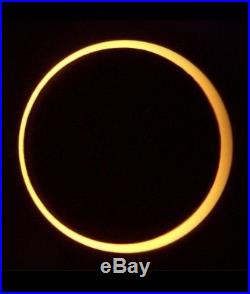





Solar eclipse (as seen from the planet Earth) is a type of eclipse that occurs when the Moon passes between the Sun and Earth, and when the Moon fully or partially blocks (“occults”) the Sun. This can happen only at new moon when the Sun and the Moon are in conjunction as seen from Earth in an alignment referred to as syzygy. In a total eclipse, the disk of the Sun is fully obscured by the Moon. In partial and annular eclipses, only part of the Sun is obscured. A total solar eclipse occurs when the Moon completely covers the Sun’s disk, as seen in this 1999 solar eclipse. During a partial solar eclipse (right), the Moon blocks only part of the Sun’s disk (October 23, 2014). If the Moon were in a perfectly circular orbit, a little closer to the Earth, and in the same orbital plane, there would be total solar eclipses every new moon. However, since the Moon’s orbit is tilted at more than 5 degrees to the Earth’s orbit around the Sun, its shadow usually misses Earth. The Moon’s orbit must cross Earth’s ecliptic plane in order for an eclipse (both solar as well as lunar) to occur. In addition, the Moon’s actual orbit is elliptical, often taking it far enough away from Earth that its apparent size is not large enough to block the Sun entirely. The orbital planes cross each other at a line of nodes resulting in at least two, and up to five, solar eclipses occurring each year; no more than two of which can be total eclipses. However, total solar eclipses are rare at any particular location because totality exists only along a narrow path on the Earth’s surface traced by the Moon’s shadow or umbra. An eclipse is a natural phenomenon. However, in some ancient and modern cultures, solar eclipses were attributed to supernatural causes or regarded as bad omens. A total solar eclipse can be frightening to people who are unaware of its astronomical explanation, as the Sun seems to disappear during the day and the sky darkens in a matter of minutes. Since looking directly at the Sun can lead to permanent eye damage or blindness, special eye protection or indirect viewing techniques are used when viewing a solar eclipse. It is technically safe to view only the total phase of a total solar eclipse with the unaided eye and without protection; however, this is a dangerous practice, as most people are not trained to recognize the phases of an eclipse, which can span over two hours while the total phase can only last a maximum of 7.5 minutes for any one location. People referred to as eclipse chasers or umbraphiles will travel to remote locations to observe or witness predicted central solar eclipses. 999 Weight: 1 Oz Diameter: 40.6 mm Mintage: 500 Pcs Worldwide Finish: 24K GOLD GILDED, RUTHENIUM AND SILVER. Certificate COA: Yes Box: Yes. The item “2017 1 Oz Silver $1 SOLAR ECLIPSE OF THE SUN EAGLE Ruthenium Coin WITH 24K GOLD” is in sale since Monday, June 18, 2018. This item is in the category “Coins & Paper Money\Coins\ US\Commemorative\Modern Silver/Clad (1982-Now)”. The seller is “luispapi1983″ and is located in Absecon, New Jersey. This item can be shipped worldwide.
- Year: 2017
- Denomination: $1
- Circulated/Uncirculated: Uncirculated
- Certification: Uncertified
- Composition: Silver
